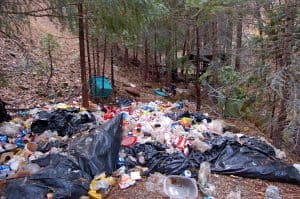Share this article
An ever-changing ecological battlefield — from The Wildlife Professional
Frozen in the act of scavenging dinner, the vulture’s head lay on the fox’s abdomen, covering the hole it had been attempting to enlarge. When biologists pulled the bird away, they found not only a healthy looking, though dead, fox underneath, but also scores of insects scattered around. Less than a mile away the scene was repeated. This time the dead animal was a black bear, again with a vulture lying on top of it and numerous insects scattered nearby.
These two scenes, which biologists found during raids conducted last year in California’s Lassen National Forest on “trespass marijuana grow sites,” highlight the broad and gruesome nature of wildlife poisoning associated with illegal marijuana cultivation on public, tribal, state and private lands across the United States. Today, growers use a wide variety of legal and illegal toxicants to protect the crop from rodents chewing irrigation lines and omnivores raiding food supplies.
Wildlife poisoning is ubiquitous at these illegal grow sites, both intentional and secondary. Preliminary tests conducted by the University of California, Davis California Animal Health and Food Safety laboratory (CAHFS) indicated that the insects were contaminated with carbofuran, an insecticide banned in the U.S. but increasingly found at these sites. In fact, the presence of dead insects on or around a carcass is often an early indicator of poisoning via concentrated pesticides. The compounds are so toxic that insects landing on the carcass die within minutes of contact (R. Poppenga, CAHFS, personal communication).
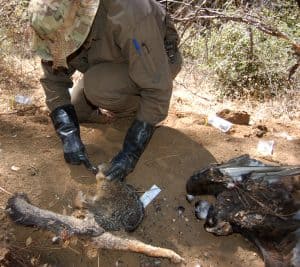
Author Mourad Gabriel of the Integral Ecology Research Center samples a fox and vulture found dead at an illegal trespass marijuana cultivation site on the Lassen National Forest in California. The small black dots on the ground between the animals are flies that died from eating the decaying carcasses. ©Greta Wengert, IERC
Until recently, research on the impacts of toxicant exposure focused on fishers (Pekania pennanti), one of the most intensively studied mammals in the western U.S. One early study documented that of 58 dead fishers collected in California between 2006 and 2011, 79 percent had been exposed to toxicants used at trespass grow sites. However, these 58 animals died from a variety of causes, including predation, disease and poisoning. Of these animals, four died as a direct result of poisoning from toxicants (Gabriel et al. 2012). By 2015, the exposure rate of deceased fishers climbed to 85 percent with a total of 13 pesticide-related deaths (Gabriel et al. 2015). Even more recently, testing of 22 additional fisher carcasses collected since November 2015 now puts the exposure rate at 100 percent (M. Gabriel, Integral Ecology Research Center, unpublished data).
However, not only fishers are being impacted by the expansion of illegal marijuana sites. As the various carcasses of vultures, foxes and bears found in 2016 indicate, the effects of indiscriminate toxicant use at these sites are widespread.
An expanding problem
Today, biologists routinely find the carcasses of species such as mule deer (Odocoileus hemionus), gray foxes (Urocyon cinereoargenteus), Steller’s jays (Cyanocitta stelleri), ravens (Corvus corax) and coyotes (Canis latrans) at grow sites. These species are victims of both primary and secondary poisoning. One northern spotted owl (Strix occidentalis caurina) found by a biologist tested positive for anticoagulant rodenticide exposure, and 40 percent of barred owls (Strix varia) tested as a surrogate for spotted owls were positive for rodenticide exposure (D. Hansen, personal communication). Small mammal carcasses are often scattered across grow sites, too. Detailed site investigations have led to the discovery of black bear graves, where forensic evidence revealed that the bears were shot at near pointblank range, indicating the animals were likely incapacitated in some way, allowing the shooter to closely approach the animal.
But not only wildlife is at risk. Trespass grow sites often contain concentrated pesticides in unmarked containers that pose a severe danger to recreational users of public lands. Carbofuran is an extraordinarily toxic agricultural insecticide. Growers often store the concentrate, bubble gum pink in color, in soda and Gatorade bottles. Just a drop is sufficient to kill an adult human. At unremediated grow sites, bottles with the toxicant may lie on the ground for years until they are punctured by animal bites or gnawing. The simple act of picking up the bottle without gloves to properly dispose of it may be enough to expose a person to the poison. Should a child pick up a bottle and sniff it or lick their fingers, the effects would be immediate.
Other avenues for exposure exist as well. In one case, a bleach bottle used to reconstitute zinc phosphide insecticide was found lying in a sunny meadow. Heat had caused the bottle to build up internal pressure, and when a researcher touched it, the bottle exploded, spraying phosphine gas (M. Gabriel, IERC, personal observation). Dogs have also died after eating bait left around un-remediated grow sites (J. Davis, USDA Wildlife Services, personal communication).
In 2011 the U.S. Forest Service reported trespass grow sites on 67 national forests in 20 states (HSDL 2011). At one site on the Rogue River-Siskiyou National Forest in Oregon, researchers recently found 66 pounds of a wide array of toxicants, all within habitat used by both fishers and northern spotted owls (D. Clayton, USDA Forest Service, personal communication). In the words of Shane Krogen, a pioneer in early volunteer reclamation efforts who died during a 2013 cleanup effort, “There is no gray area when it comes to this aspect of illegal marijuana grows [pesticide/rodenticide use]; the wildlife is killed, plain and simple. Based on the tools that have been collected and the carcasses that have been identified, the growers are engaged in a war with the natural world for the resources they require to continue their production” (Krogen 2010, unpublished report).
Vectors for dispersal
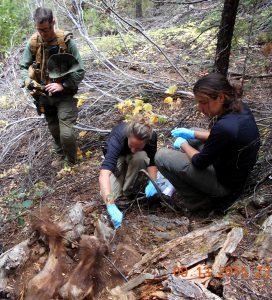
Greta Wengert (center) of the Integral Ecology Research Center takes a sample from the carcass of a black bear found on national forest land as research technicians observe. Laboratory analysis at the University of California Davis confirmed pesticide exposure as the cause of the animal’s death. ©Mourad Gabrie
As this war continues, more focused research is uncovering the multitude of ways these toxins impact the natural world. Poisoned rodents may survive several days, often exhibiting erratic behavior and moving outside the vicinity on their own or via predators. For example, carnivores may take the animals back to a nest or den to feed dependent offspring. On two occasions, the carcasses of nursing fisher kits tested positive for rodenticide exposure, suggesting that the compounds can be transferred via milk (Gabriel et al. 2012, C. Thompson, unpublished data). Rodents captured up to 12 months following site eradication tested positive for anticoagulant rodenticides, but so far there’s no data on when the animal consumed the toxicant and whether a positive test indicates persistence of the compounds in the animal’s tissue or in the environment (G. Wengert, IERC, personal communication).
While invertebrates succumb immediately to insecticides such as carbofuran or malathion, they are immune to many rodenticides that disrupt the vitamin K-dependent blood clotting biochemical mechanism in mammals. In fact, invertebrates can accumulate rodenticide compounds in their tissue without negative effects and move beyond the grow site boundaries, thereby facilitating secondary poisoning at outlying sites (Gabriel et al. 2014). The consequence of this mobility is that small- to midsized predators, such as fishers, martens (Martes americana), and ringtails (Bassariscus astutus), or raptors such as the northern spotted owls or northern goshawks (Accipiter gentilis), may be at risk of accumulating toxicants at sub-lethal doses. Doses too low to cause direct mortality may still have individual- and population-level consequences through reduced immune response, decreased reproductive potential and increased susceptibility to predation (Thompson et al. 2014). Some amphibians — including the California red-legged (Rana draytonii) or mountain yellow-legged frog (Rana muscosa) — are particularly vulnerable due to the synergistic effects of insecticide exposure and predatory stress (Relyea 2004).
A shifting ecological battlefield
Over the years, the nature of the toxicants found at these sites has changed. Prior to 2014, it was common to see dozens of small D-Con packets distributed widely around a trespass grow site. However in 2014, California enacted a ban on the sale of individual-use packages of second- generation anticoagulant rodenticides (SGAR) to consumers. This limited the sale of chemicals such as brodifacoum, the active ingredient in D-Con, to restricted-use licensed applicators and reduced the availability of these rodenticides to trespass growers. Yet instead of reducing the level of contamination at these sites, the ban appears to have sparked somewhat of a bio-warfare arms race.
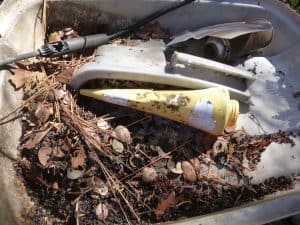
A bottle shows multiple canine punctures on debris collected during a volunteer remediation effort on the Sierra National Forest, California. ©Craig Thompson
In some cases, SGAR compounds have been replaced by more lethal and commercially accessible alternatives such as cholecalciferol, which calcifies the internal organs of the animal that consumes it, or the neurotoxin bromethalin. SGAR bait stations have also been replaced by the use of larger quantities — 5- to 20-pound buckets — of older, but still readily available, first-generation anticoagulant rodenticides (FGAR) such as warfarin or diphacinone. Less lethal than SGAR compounds, FGARs often require multiple feedings over a period of days to cause mortality, which can increase the risk of secondary poisoning.
The use of illegal carbamate-based pesticides such as carbofuran, which both reduces insect damage to marijuana plants and poisons mammals (Richards et al. 2011), has increased as well. Prior to 2014, biologists seldom encountered carbofuran at grow sites although documentation was sporadic. Use has increased, however, with carbofuran found at 34 percent of the 32 marijuana cultivation sites visited by researchers in 2015.
In the last five years, scientific understanding of the magnitude of the problem has begun to coalesce into both an emerging field of research and a path toward effective remediation. Earlier work documenting the widespread poisoning of fishers (Gabriel et al. 2012, Thompson et al. 2014) opened the door for research into threats such as water and soil contamination. Hydrologists, toxicologists and biochemists have become increasingly involved and the focus has shifted from simply eradicating marijuana plants to also carefully documenting and remediating environmental damage such as water diversion, wildlife poisoning and erosion. In some cases, partnerships between researchers; federal, state and local agencies; the National Guard and nonprofits have resulted in improved remediation and better communication with the public regarding the collective cost to public resources.
Challenges to reclamation
In 2015, a week-long collaborative effort on the Shasta-Trinity National Forest in California cleaned seven sites, removing 12.2 tons of garbage and 26 miles of irrigation pipe. In an unpublished report to the California Department of Fish and Wildlife, IERC documented the use of more than 8,000 pounds of fertilizer and 53 pounds of pesticides at these sites. While this reclamation effort may seem like just a drop in the bucket, effective remediation and the removal of infrastructure consistently deters future illegal activity and reduces the probability of sites being reused.
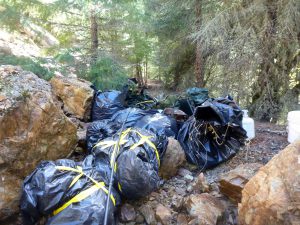
Illegal marijuana growers leave behind massive amounts of toxic trash. These before and after shots taken in California’s Shasta-Trinity National Forest shows a reclamation conducted by a collaborative volunteer effort. A helicopter was needed to remove the trash from the remote location. ©Mourad Gabriel
Unfortunately, not only are the logistics of restoring remote locations difficult and expensive, the increased use of concentrated toxicants poses significant human health hazards and requires the presence of trained personnel. Collaborative agency and volunteer efforts have been successful at both efficiently remediating sites and competing for restoration-based grant funds; however, concern about the welfare of volunteers has caused reclamation activity to decline.
To alleviate this concern, some managers have turned to the use of private, hazmat-trained contractors. Paying these contractors to also collect household trash and remove irrigation lines dramatically inflates the overall cost, resulting in a growing backlog of illegal sites that have not been cleaned up, according to IERC in an unpublished report to the California Department of Fish and Wildlife. Given the scope of the problem, collaborative efforts that use trained personnel where necessary but also take advantage of volunteer resources are sorely needed.
Clearly, however, the magnitude of the problem is staggering. Estimates of the number of sites vary, but a conservative estimate suggests several hundred new trespass grow sites pop up every year in the western U.S. (G. Wengert, IERC, personal communication). Law enforcement locates and raids roughly 20 to 40 percent of sites each year, and only about 10 percent of those are cleaned and effectively remediated. This means hundreds to thousands of sites, known and unknown, remain scattered across western public lands. The risk to recreational users of public land who could innocently come in contact with unmarked containers is also a major concern. Not only have we lost many of our natural resources to this epidemic, but the public is unknowingly losing their safe access to them as well.
Even if growing activities were stopped today, the backlog of these ecological land mines is still large. Without remediation, we know that the toxicants associated with these sites will gradually disperse across the landscape via water and wildlife
However, recently, the public has become more aware of the threats. Over the past four years, seven research publications and book chapters have been published on the ecological damage created by trespass grow sites, and over 100 media reports worldwide have addressed the issue. The news has generated both anger and action on the part of the public. In fact, several California counties have created volunteer reclamation teams and are collaborating with law enforcement and researchers, a combination that is proving to be both effective and efficient. In addition to the Shasta-Trinity National Forest example described above, local efforts on the Sierra, Sequoia, Lassen, Mendocino and Six Rivers national forests have successfully removed the toxins and infrastructure associated with some trespass grow sites.
But assessing the overall impact of reclamation efforts is difficult without knowing what’s actually hidden on public lands. Due to the widespread nature of the problem, the only way to efficiently address it is through collaborative efforts and on a regional scale.
 Craig Thompson is a research wildlife ecologist with the U.S. Forest Service, Pacific Southwest Research Station.
Craig Thompson is a research wildlife ecologist with the U.S. Forest Service, Pacific Southwest Research Station.
 Kathryn Purcell is a research wildlife biologist with the U.S. Forest Service, Pacific Southwest Research Station.
Kathryn Purcell is a research wildlife biologist with the U.S. Forest Service, Pacific Southwest Research Station.
 Mourad Gabriel is the executive director of the nonprofit Integral Ecology Research Center and a research associate at the University of California Davis, Wildlife Health Center.
Mourad Gabriel is the executive director of the nonprofit Integral Ecology Research Center and a research associate at the University of California Davis, Wildlife Health Center.
Header Image: Illicit marijuana cultivators often leave behind toxicants that poison wildlife such as these partially full buckets of bromethalin recovered on the Rogue-Siskiyou National Forest in Oregon. ©Mourad Gabriel





